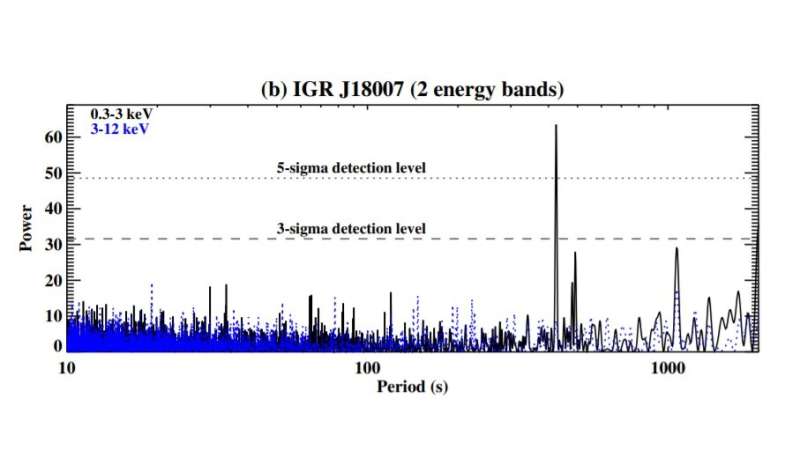February 2, 2022 report
IGR J18007–4146 is an intermediate polar, study finds

Using ESA's XMM-Newton and NASA's NuSTAR spacecraft, astronomers have observed a galactic source designated IGR J18007–4146. The observational campaign has found that this source is an intermediate polar. The finding is reported in a paper published January 26 on arXiv.org.
Cataclysmic variables (CVs) are binary star systems consisting of a white dwarf accreting material from a normal star companion. They irregularly increase in brightness by a large factor, then drop back down to a quiescent state. Polars are a subclass of cataclysmic variables distinguished from other CVs by the presence of a very strong magnetic field in their white dwarfs.
In some CVs, accretion occurs through a truncated accretion disc when the white dwarf is moderately magnetic. These systems are known as intermediate polars (IPs). Observations have shown that in IPs, the magnetic white dwarf spins asynchronously with the orbital period of the system and therefore produces a rapid oscillation with the spin period. Therefore, determining precise spin period and precise oscillation ephemeris could be the key to reveal the IP nature of some CVs.
IGR J18007–4146 was first spotted by the International Gamma-Ray Astrophysics Laboratory (INTEGRAL) spacecraft as an unclassified galactic X-ray source. Follow-up observations of this source NASA's Chandra X-ray observatory have suggested that it may be a cataclysmic variable.
In order to further test this scenario, a team of astronomers led by Benjamin M. Coughenour of the University of California, Berkeley, has performed simultaneous observations of IGR J18007–4146 in October 2020 with XMM-Newton and NuSTAR. The results confirmed the CV nature of this source and found that it is an intermediate polar.
"Utilizing simultaneous XMM-Newton and NuSTAR observations, as well as the available optical/IR data, we confirm the nature of IGR J18007–4146 as an intermediate polar type CV," the researchers wrote in the paper.
The observations of IGR J18007–4146 found a hard X-ray continuum, but also a strong iron (Fe) line complex between 6 and 7 keV, a distinct soft component (often seen in IPs), and intrinsic partial covering absorption. It was noted that the three distinct iron lines suggest that the source is an accreting white dwarf rather than a black hole or neutron star.
Furthermore, the study detected periodic signals in the XMM data, indicative of an IP, but could also be explained by a slowly rotating neutron star in a high-mass X-ray binary (HMXB) or by a symbiotic X-ray binary (XRB). However, the effective temperature of the companion object, estimated to be some 6,500 K, excludes the HMXB/XRB scenario and therefore favors the hypothesis that IGR J18007–4146 is an IP accreting from a low-mass companion.
The observations also found that IGR J18007–4146 has a luminosity of 7.7 decillion erg/s, what is typical for other known IPs, and that its spin period—measured to be approximately 424.4 seconds—is well within the expected range among IPs. Additionally, the researchers have calculated that the mass of the white dwarf is around 1.06 solar masses, what means that IGR J18007–4146 is more massive than average magnetic CVs.
More information: Classifying IGR J18007–4146 as an intermediate polar using XMM and NuSTAR, arXiv:2201.11170 [astro-ph.HE] arxiv.org/abs/2201.11170
© 2022 Science X Network





















